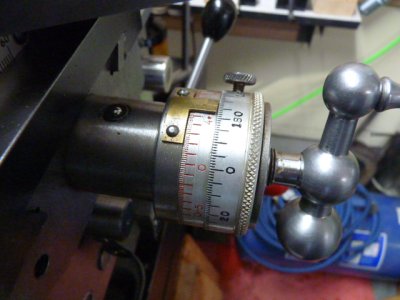Below is the video link to the Colchester Lathe Inch/Metric Dials
Watch "Colchester Lathe Inch/Metric Dials" on Streamable.
streamable.com
These dials were an option on these lathes, but my Master 2500 came with them. They are installed on the cross slide and the compound. They are labelled GMT.
Here is a drawing for them.
In a nutshell, here is how they work.
There are two co-axial dials, each is driven by a internal ring gear. One has 125T the other 127T. There is a common spur gear inside them. As you rotate the 125T dial, the 127T dial will take longer to make one full revolution, the ratio of difference being the imperial/metric conversion constant. You could also rotate the 127T dial one rotation and the 125T would rotate more than one full turn - the amount being, again, the imp/metric constant.
The shield is rotatable in either direction. There are tiny, spring loaded ball detents that locate it in either the metric position or, 180* opposite, the imperial position. Only one of the scales is ever visible when looking down from the operator‘s position.
The scale closest to the lead screw (either compound or cross slide) tells you what type of lathe you have. In my case, the imperial scale is closet to the lead screw, so it is an imperial lathe.
So in the video, I demonstrate how this works using the compound - the cross slide would be identical except that the dials are 5.00mm / 0.200” for one full turn. The compound is only 2.50mm/0.100” per rev.
First I show that both dials are at zero I turned the dial many times to get them to line up for demo purposes, as during use, you don’t care at all where the 0s are in relation to each other as the ratio is always the same. (The only way that this ratio could ever change, is if you have the gear jump a tooth - that would surely destroy the ring gears and jam the dial up - so you would know).
Then I go back to metric 0, followed by one complete turn on the handle back to metric 0.
Next I move the shield to show what the equivalent imperial reading would be for 2.50mm advance:
2.50mm : 25.4 = 0.98425”. And you can clearly see that the imperial dial has moved to that approximate position.
Then I turn the shield again to go back to metric 0.
If one were to start at imperial 0 and rotated the handle on complete turn (0.100”), then the metric dial would read 2.54mm. I did not film that (I can, if proof is required).
So, yeah, very clever, true imp/metric dials done by mechanical gear ratio. Fool proof, accurate and easy to use. No power required.


